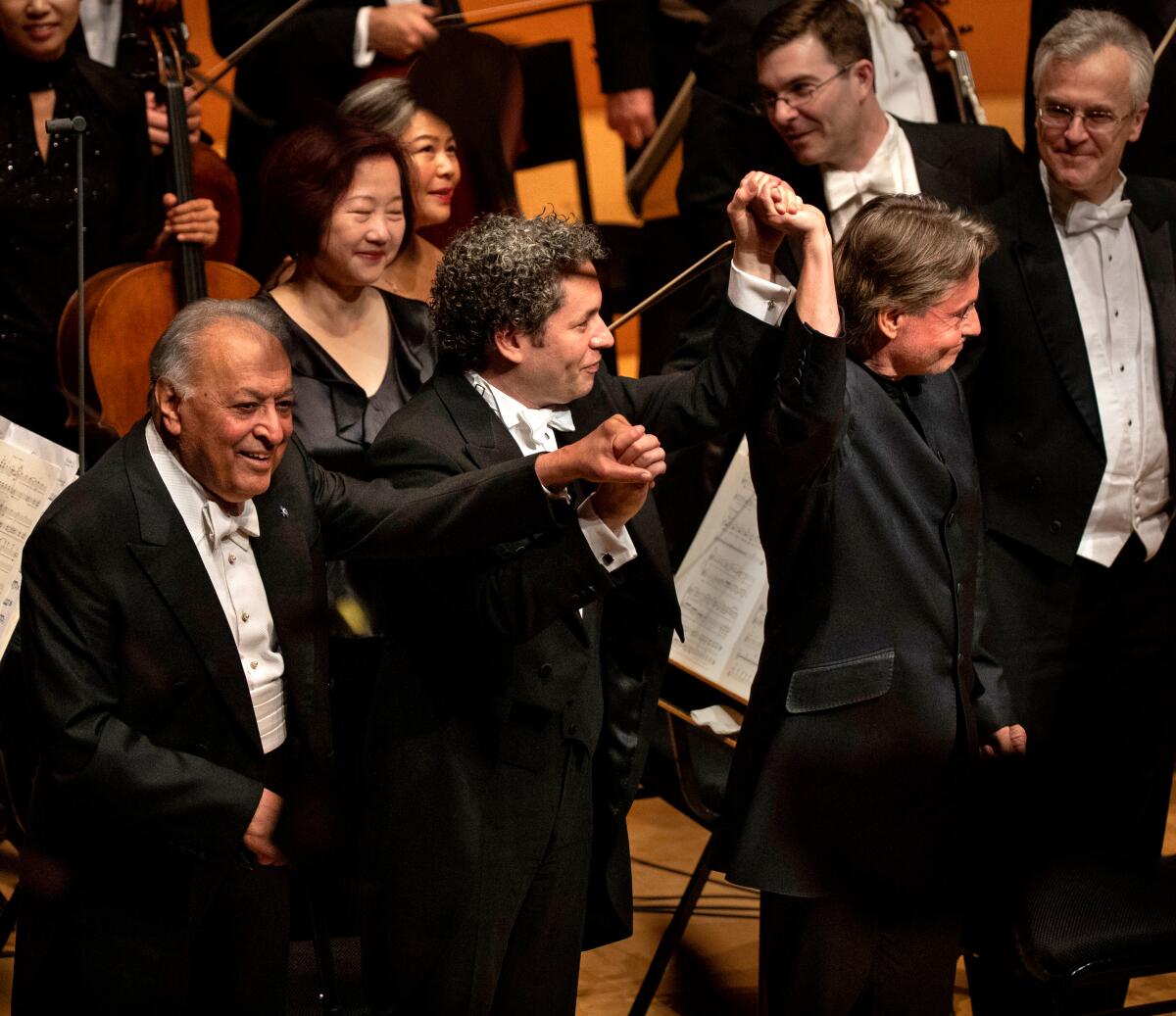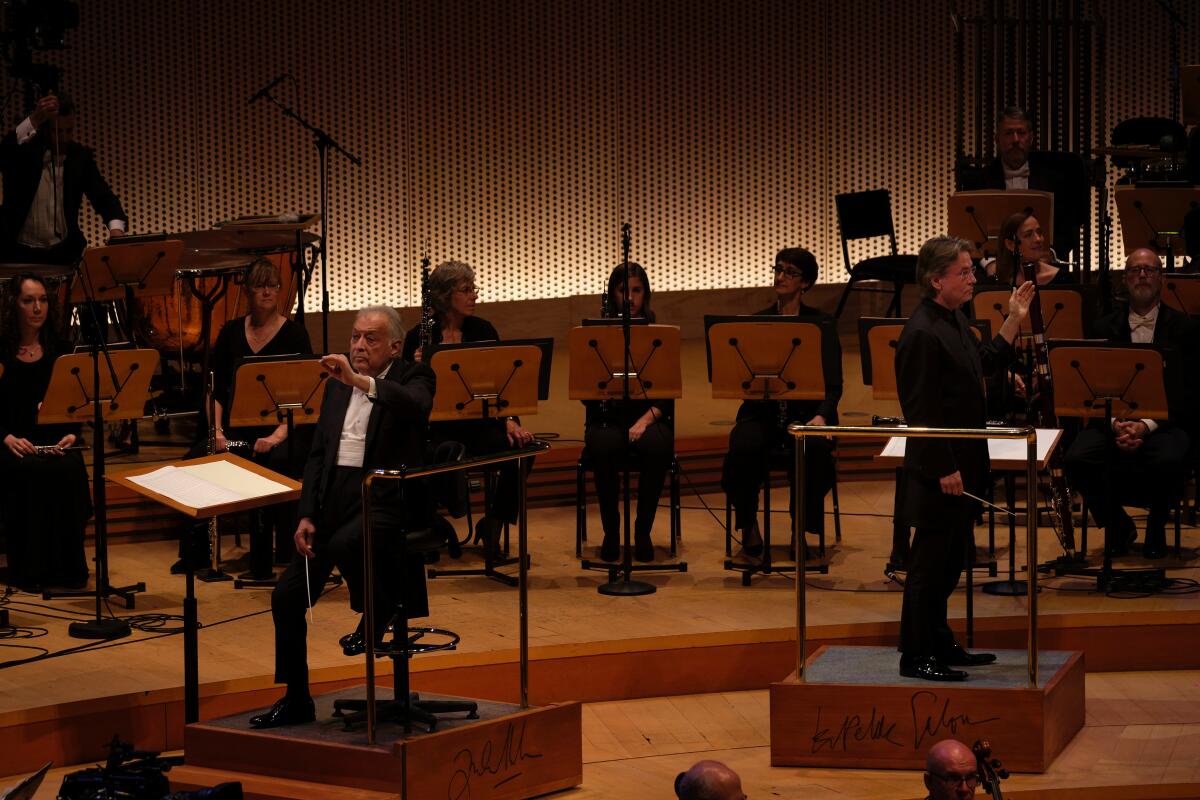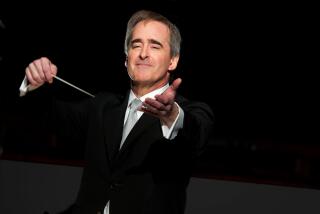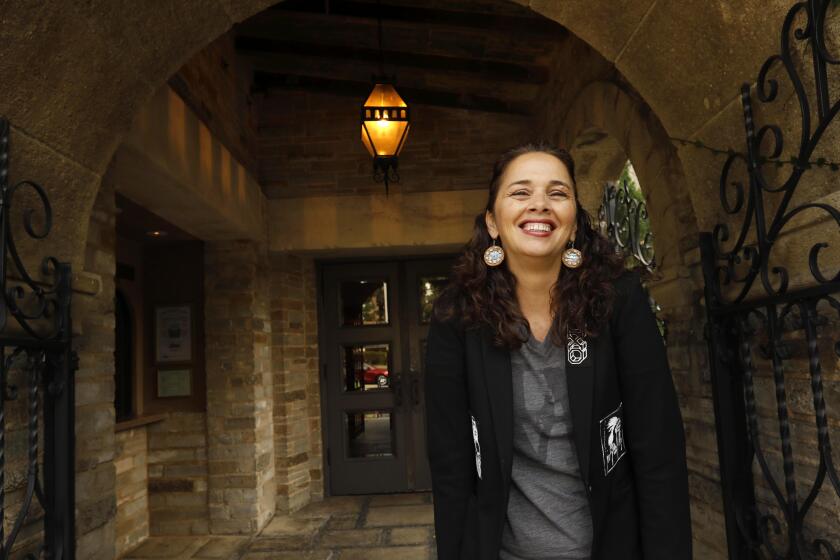Review: Three conductors, three concerts and more L.A. Phil history in the books

Most orchestra-going Angelenos can be expected to know Zubin Mehta, Esa-Pekka Salonen and Gustavo Dudamel. They are the three living Los Angeles Philharmonic music directors, encompassing 57 years of the orchestra’s history. They also happen to be three of the biggest names in the business and celebrities in town.
Many of us grew up with one of them. They all have had affectionate L.A. nicknames, although Mehta has long outgrown the 1960s Zubie Baby and Dudamel, more recently, The Dude. Salonen’s is E-P. Mehta (now conductor emeritus) and Salonen (conductor laureate) never severed connections with the orchestra and remain loyal to the community. We may easily kid ourselves into thinking we have a good idea of what to expect from them.
There was no kidding possible, however, at Walt Disney Concert Hall this past weekend when each conductor spent an evening with his orchestra as part of the L.A. Phil’s 100th birthday party. For the gala on the big night Thursday, Mehta, Salonen and Dudamel each led a work or two, followed by the premiere of “From Space I Saw Earth” for three conductors, which Icelandic composer Daníel Bjarnason wrote for the occasion. Then it was time for the maestros to come down from the clouds and show what they really can do.

On Friday night, Mehta picked Mahler’s 80-minute Second Symphony (“Resurrection”). There are recordings of him conducting it with the Vienna Philharmonic in 1975, the New York Philharmonic in 1982 and the Israel Philharmonic in 1994. They are all quite similar, showing off potent orchestral attacks, knife-sharp edges. Instrumental colors are neon-lit. Everything is geared toward climaxes, which come with devastating force. Just whose resurrection is this anyway, you might ask? Godzilla’s?
The recordings are compulsively listenable, as was Friday’s bigger, grander and more gripping performance. After a two-year battle with cancer, the 83-year-old conductor got onstage using a cane, which he then cavalierly dropped on the floor before taking a seat to conduct.
It turns out all those attention-getting old Mehta gestures were just that. The integrity of the music-making came from elsewhere, and never was that more apparent in the sheer intensity of sound — deep, rich, all-suffusing — he could get from the L.A. Phil, with his two vocal soloists, Golda Schultz and Mihoko Fujimura, and the Los Angeles Master Chorale equally meeting Mehta on his own exulted level. He’ll be back conducting the “Resurrection” with the L.A. Phil in January. Your Christmas shopping may have just gotten easier.
Like Mehta, Salonen was in very familiar territory Saturday night. Between two pieces by his fellow Finnish composer Sibelius, Salonen sandwiched the premiere of a piece that the L.A. Phil commissioned from him for its past centennial season but which Salonen only now finished.
Four years ago, Salonen led a force-of-nature performance of Sibelius’ Fifth Symphony with his London orchestra, the Philharmonia, in Orange County. He gave the premiere of the first part of his own “Gemini” with the L.A. Phil last season. Salonen finally finished the second part in time to give that premiere the week before introducing a less well-balanced program featuring an excellent, if hardly necessary, conventional performance of Tchaikosvky‘s ubiquitous Violin Concerto, featuring sumptuous young soloist Daniel Lozakovich. Bartók’s Concerto for Orchestra was the highlight.
Salonen originally dubbed the two sections of “Gemini” after twins from Greek mythology, “Pollux” and “Castor.” The movements are held together by a postgrunge bass line Salonen heard in a Paris restaurant and wrote down on a napkin. Two tympani beat it out, dramatically slowed down. The rest of the piece is airy, slow, moody, harmonically hazy. When I first heard “Pollux” last year, it entranced but didn’t feel finished — because it wasn’t.
Now there is “Castor,” which is an adrenaline rush, spectacularly orchestrated and rhythmically exhilarating. It is a conductor’s piece, meant to dazzle. During rehearsals of “Castor,” Salonen replaced bass drums with Japanese taiko drums, and on Saturday he made the same change with “Pollux.” There is also a very brief new transition between the two, creating a just-under-24-minute whole, a satisfying two-parter of anticipation and release full of never-predictable twists and turns.
Salonen began the program with Finnish myth, the seldom-heard “Luonnotar.” A dramatic tone poem for soprano and orchestra, this 10-minute sketch of an opera Sibelius never wrote is a visceral account of an incident in the Finnish epic poem “Kalevala.” Schultz was again the imposing soloist. Still, for all of his evocative theater music, Sibelius wasn’t an opera composer. His Fifth is fluid music, rather without a dramatic road map to follow, instead setting symphonic waves in motion that take you where they will. Salonen’s overwhelmingly vivid performance, visionary and Romantic at the same time, had what virtual realty can only thus far dream of — the grandiosity of sense of place without the artificiality.
Sunday afternoon Dudamel conducted Beethoven’s Ninth Symphony, the “Ode to Joy” being one of his calling cards. He’s led big, big Ninths here reflecting big, big moments, such as the 2009 free Hollywood Bowl concert to begin his music directorship. He also has conducted the symphony with two big orchestras together, the L.A. Phil and his Simón Bolívar Symphony Orchestra of Venezuela. He has experimented, as well, with what to introduce the symphony, usually trying to find a piece that deals with Beethovenian brotherhood from a different angle.

This time he commissioned Mexican composer Gabriela Ortiz, who came up with a startlingly original idea: a piece that could also become a sketch for an opera, “Yanga,” for percussion ensemble, orchestra and chorus. Gaspar Yanga is a forgotten 16th century freedom fighter, a Mexican slave and former African prince who became a Robin Hood, stealing from the rich to buy his people liberty. With a text by Santiago Martín Bermúdez along with Congo chants sung by the Master Chorale, the score included solos for African percussion instruments, which were played by Tambuco Percussion Quartet.
Like Salonen, Ortiz has a slow, atmospheric and harmonically arresting introduction, though a brief one, before her rhythmically compelling evocation of Yanga, an operatic hero if there ever was one. I hope Ortiz, who does seem to have an opera in her, actually writes one.
Dudamel’s Beethoven Nine was the last surprise. In the past he’s dwelt on the monumental nature of the score. Now, he’s exchanged that for speed, relying on spine-tingling orchestral virtuosity in a suave, streamlined performance unlike any Beethoven he has conducted here in the past.
The rethinking offered new emphasis on interior lines and a velocity that expected Beethoven’s heaviest symphony to fly on insect’s wings. In so doing, it became practically a matter of life and death that the Master Chorale and vocal soloists Schultz, Tamara Mumford, Mario Chang and James Rutherford had to keep up with an unstoppable L.A. Phil, and they managed. Freedom, Dudamel demanded with “Yanga” and this “Ode to Joy,” can’t wait.
More to Read
The biggest entertainment stories
Get our big stories about Hollywood, film, television, music, arts, culture and more right in your inbox as soon as they publish.
You may occasionally receive promotional content from the Los Angeles Times.







